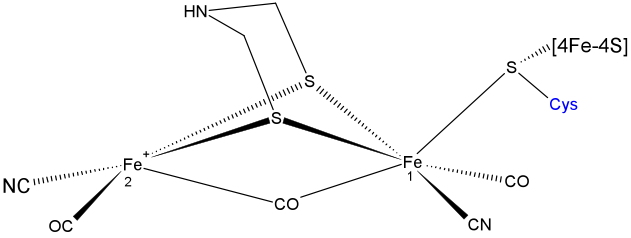Furtak Research Projects
Bio-Catalysts for Solar Hydrogen Production
 Nature has developed very efficient enzymes, called hydrogenases, which catalyze the reversible reaction between hydrogen ions and hydrogen which have iron and nickel structures as their active sites. The iron-only hydrogenases are very efficient, and have promise of replacing platinum as catalysts for hydrogen production. This is the molecular structure of the active site in these materials. In the biological process electrons are supplied to this site to drive the reaction. The objective of this research project is to couple Fe-Fe hydrogenase to inorganic nanostructures that would artificially supply the electrons. This would be particularly useful if the electrons were directly created by solar light absorption in the nanoparticle
Nature has developed very efficient enzymes, called hydrogenases, which catalyze the reversible reaction between hydrogen ions and hydrogen which have iron and nickel structures as their active sites. The iron-only hydrogenases are very efficient, and have promise of replacing platinum as catalysts for hydrogen production. This is the molecular structure of the active site in these materials. In the biological process electrons are supplied to this site to drive the reaction. The objective of this research project is to couple Fe-Fe hydrogenase to inorganic nanostructures that would artificially supply the electrons. This would be particularly useful if the electrons were directly created by solar light absorption in the nanoparticle
 Before this goal can be reached it is necessary to understand how hydrogenase interacts with inorganic surfaces. We are using attenuated total reflection (ATR) infrared spectroscopy to monitor the vibrational modes of the ligands in the active site as the enzyme adsorbes to the ATR surface. Our initial studies involved IR transmission measurements of concentrated solutions of hydrogenase I from C. acetobutylicum (CaI). The data show the carbonyl range of the vibration spectrum for: (A) the as-prepared sample, (B) a sample that was chemically oxidized, (C) a sample that treated with carbon monoxide to inhibit its action as a catalyst, and (D) a sample that was chemically reduced. These results demonstrate that IR spectroscopy is capable of following the oxidation state of the active site and also monitoring whether the enzyme is active.
Before this goal can be reached it is necessary to understand how hydrogenase interacts with inorganic surfaces. We are using attenuated total reflection (ATR) infrared spectroscopy to monitor the vibrational modes of the ligands in the active site as the enzyme adsorbes to the ATR surface. Our initial studies involved IR transmission measurements of concentrated solutions of hydrogenase I from C. acetobutylicum (CaI). The data show the carbonyl range of the vibration spectrum for: (A) the as-prepared sample, (B) a sample that was chemically oxidized, (C) a sample that treated with carbon monoxide to inhibit its action as a catalyst, and (D) a sample that was chemically reduced. These results demonstrate that IR spectroscopy is capable of following the oxidation state of the active site and also monitoring whether the enzyme is active.
Current studies are being conducted with a flow-through ATR sample chamber equipped with a silicon ATR element. We are investigating the kinetics of the adsorption of model proteins whose surface chemical behavior is similar to the Fe-Fe hydrogenase enzymes. The long-range objective includes using chemical modifiers to control the interaction between the enzyme and the inorganic support.
The project is a collaboration with Reuben Collins and with Paul King at NREL and is supported by the Department of Energy. The work is being done by grad student Mike Ratzloff.
